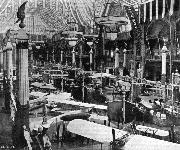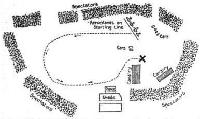L.Opdyke French Aeroplanes Before the Great War (Schiffer)
Deleted by request of (c)Schiffer Publishing
Train
Emile Train was the son of a manufacturer at St Etienne, near Lyon, and today is more famous for his motors and motorcycles built after World War I than for his early aeroplanes. These were of excellent design, but Train lacked the funds to compete with better-established builders, and his steel tube construction required skills that were not always available. Expert in mechanics and oxyacetylene welding, Train built his fortune by designing and building automatic vending machines. By the end of 1909 he had set up a hangar southwest of the camp-site at Mourmelon and began work on his first monoplane. After 3 months he was able to fly it, and he was breveted on 9 April 1910.
His monoplane was an all-metal copy of the Demoiselle, using wood only for the ribs. There were no turnbuckles, for ease of disassembly, and many parts were interchangeable, using bolted collars. The fuselage was deeper than the Demoiselle's, and the elevator was fitted under the rudder. The rectangular wings were double-cambered, thickening slightly behind the leading edge, and the tail surfaces consisted of a standard set, unlike the Demoiselle and its universal joint. The Anzani was mounted on the leading edge above the pilot.
In December 1910 Train had modified his monoplane and was building a 2-seater which flew early in January; it was developed from the single-seater by simply bolting on outer wing panels and fitting side-by-side seating in the front fuselage which had fabric-covered streamlined panels on either side, giving the appearance of a teardrop-shaped nacelle. The undercarriage was strengthened, and the engine was now set slightly ahead of the wing. Some machines had a streamlined fairing behind the engine; some had a gutter to keep oil from the crew. The 1911 catalogue emphasized the Train's stability and ease of handling in gusts or strong winds, which Train himself often demonstrated.
(Single-seater: span: 9.3 m; length: 8 m; wing area: 16 sqm (20 sqm): empty weight: 260 kg; 30 or 60 hp Anzani or 50 hp Gnome)
(2 seater: span: 10.6 m; length: 8 m; wing area: 20 sqm; empty weight: 280 kg; 30 or 60 hp Anzani or 50 hp Gnome - 70 hp Gnome recommended for 2-seater)
The Train monoplanes remained generally unnoticed until Train's accident at the Paris-Madrid race in May 1911, when his engine cut out just after take-off; he tried to get back to the field at Issy to avoid horsemen ahead of him. He pulled back on the stick just before flareout, stalled, and crashed onto a group of VIPs wandering out on the field, killing the Minister of War. The crash put Train and his aeroplane on the front page. It was clear, and quickly admitted, that the pilot was not to blame; Train was allowed to begin the race again the next day in another machine (some reported it was the same one, repaired), and the aviation press printed frequent laudatory articles about the designer and his aeroplane. The Train proved very reliable in this and future competitions.
The biggest operating advantage of the Trains was that the steeltube structure did not deform in wet weather; primarily for this reason 5 (some reports say 7) single-seaters were bought by the Army for tests in the Colonies in Algeria, and they were sent to the school at Biskra, in the Sahara. These particular aircraft had 3-cylinder Anzanis instead of Gnomes to save weight. In 1911 Train offered a seaplane, either similar to the 1910 Anzani-powered model or the same machine, with 2 short floats replacing the wheels and a third fitted to the tailskid.
Although his aeroplanes were good ones, Train could not manage without financial assistance, and this was provided in 1911 by Henri Deutsch de la Meurthe. Train sold his hangar facilities to Sanchez-Besa, and his designs became part of Astra, as Astra-Train. In 1912 a new Train seaplane appeared, this time with a large rectangular pontoon with extensions on each side forward, apparently to protect the pilot. This huge float, 3 m long and 2 m wide, proved unsatisfactory and was abandoned.
(Span: 12.94 m; length (with float): 8.44 m; wing area: 21 sqm; 50 hp Gnome, fully cowled)
Jane's All The World Aircraft 1913
TRAIN. E. Train, Buoy, Camp de Chalons (Marne).
Model and date. 1-seater 2-seater Hydro-mono.
Monoplanes.
Length.....feet (m.) 26? (8) 26 (8) 26 (8)
Span.......feet (m.) 30? (9.30) 35 (10.66) 42? (12.94)
Area.....sq.ft.(m?.) 172 (16) 215 (20) ...
Weight,
machine, lbs.(kgs.) 573 (200) 617 (280) ...
useful, lbs.(kgs.) ... ... ...
Motor...........h.p. 30/60 Anzani 70 Gnome 80 Gnome
Speed
max.....m.p.h.(km.) 59 (95) 65 (105) ...
min.....m.p.h.(km.) 47 (75) ... ...
Number built
during 1912 ... ... ...
Notes.--Steel construction. Landing: carriage wheels and skids. Control: warping and rear elevator. The hydro has one very large float which extends a considerable distance ahead of the tractor.
Журнал Flight
Flight, May 27, 1911.
PARIS-MADRID RACE.
WITH the same breath that everyone on Sunday expressed their horror at the national loss sustained by France in the death of M. Berteaux, the Minister of War, at the start of the Paris-Madrid race from Issy, it was universally acknowledged that in no real sense could either the pilot himself, M. Train, or aviation be blamed for the catastrophe. With every sympathy going out to all concerned in the terrible business, it must be evident from the first that no trouble would have arisen either to the aviator or any of the public had the intense excitement at the meeting not largely broken down all restraint and gradually induced the spectators and a group of leading officials to encroach very seriously upon the clear ground marked out as for the use solely of the flying men and the necessary officials controlling them. That the opening of the first great international cross-country meeting should be marred by this sad result will for a long time be as a cloak of sadness upon the whole of those associated together in sympathy with the future of aviation. But that it should be allowed to set back the steady advance of the art for even one day is not thinkable. That this is so is fully apparent from the immediate action of M. Monis, the French Premier himself. When consulted on behalf of the French Aero Club as to the cancelling of the whole race - they having temporarily suspended proceedings - he at once replied that the race was to continue as if nothing had happened. And so his commands were respected, and all the aviators who had not started on the Sunday in their turn were duly notified that they could take their place in the race on the Monday morning instead, all other conditions being left as they were originally.
It remains only to note with great thankfulness that at the time of going to press, following the death of M. Berteaux, the very greatest progress is being made towards recovery by M. Monis, the Premier, who is the next most seriously injured, as also his son, M. Antoine Monis, and M. Henri Deutsch de la Meurthe, the very generous sportsman who has so consistently supported both automobilism and aeronautics in the past ten years. The feelings of M. Train, the aviator, under all the conditions, may well be understood, and it must be a source of very great relief to him to have so speedily learned the result of the judicial inquiry which was at once set in motion into the exact causes of the accident. By this the examining magistrate has completely exonerated him from the slightest imprudence or negligence from first to last, he advising that no indictment of any kind could possibly be made against M. Train, who had undoubtedly done his best when the crisis arose. M. Train's own explanation of the accident before the judicial tribunal was as follows :-
"I started with the intention of making one or two circuits of the field, so as to be able to judge whether everything was going well, and to land in case there was anything to be done.
"As soon as I left the ground, I perceived that the motor was not working well. I was about to land, after making a turn to one side, when I saw a detachment of cuirassiers crossing the flying track. I then tried to make a short curve to avoid them, and to land in the opposite direction, but my motor at that moment failed more and more, and I was unable to undertake the curve. I raised the machine, so as to get over the troops and to land beyond them. At that very moment a group of persons, who had been hidden from my view by the cuirassiers, scattered before me in every direction. I tried to do the impossible, risking the life of my passenger to prolong my flight, and to get beyond the last persons of the group. I was about to come to land, when the apparatus, which had been raised almost vertically, dropped heavily to the ground. I got out from under the machine, with my passenger, believing that I had avoided any accident. It was only then that I learned the terrible misfortune."
M. Bonnier, the passenger who was flying with M. Train at the time, corroborated in every way the story of M. Train, and by a number of witnesses of the whole of the event not one disagreed as to what took place. As it was pointed out, M. Train was flying over the ground reserved entirely to aviators, and nobody, according to the regulations drawn up, was entitled to be on this open space during the starting. No doubt a great amount of sympathy is due to the organisers and the authorities who had charge of the keeping of the ground, as although four regiments of infantry and two squadrons of cavalry were present, besides many thousands of police, to keep order, with such a concourse of people - estimated at no less than 400,000 - it was hopeless, against the will of the public themselves, to keep them in check very long. And without question this persistence on the part of the public led to the catastrophe for which the whole world now mourns with France.
From the diagrammatic sketch of the Issy grounds, showing M. Train's course after starting, it will easily be seen how the flying section of the grounds was invaded by the public, as they had pressed forward well up behind the squadron of cavalry immediately by the side of where the tragedy took place. It was M. Berteaux himself who, but a few seconds before he was struck down, suggested that they, the official group then in the middle of the grounds, should set a good example to the rest of the crowd by retiring to their proper places behind the barriers, thereby recognising without question the danger of the over-confidence which seemed to have taken possession of both public and officials. That a national funeral is to be accorder to the Minister of War was almost a foregone conclusion, and this honour to him will finally and worthily close career of a man who has been friend to the art and progress of aviation.
One of the first to convey their sympathy to France in their bereavement was King George, through the British Ambassador in Paris. This was quickly followed by similar messages of regret and sympathy from Germany and all the leading countries of the world, as also the Royal Aero Club and other bodies so immediately associated with the industry.







